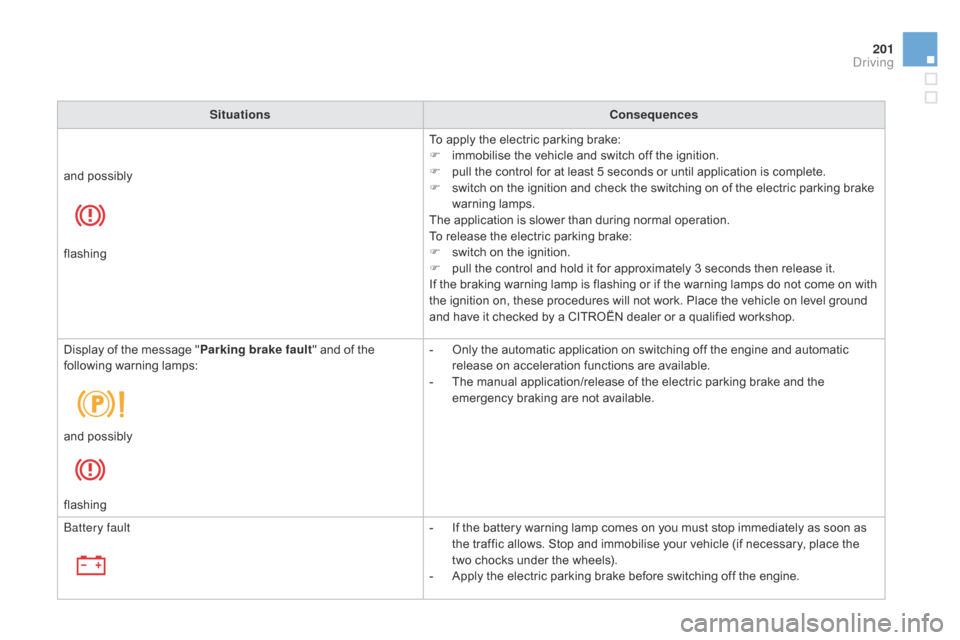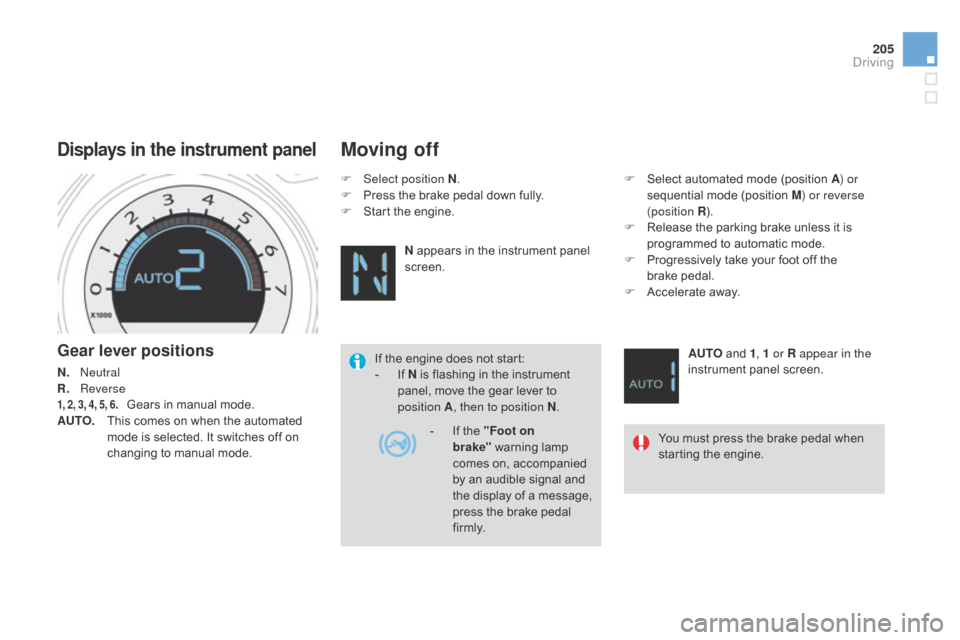Page 202 of 444

Operating faults
If the electric parking brake malfunction warning lamp comes on together with one or more of the warning lamps presented in these tables, place the
vehicle in a safe condition (on level ground, gear engaged) and contact a CITROËN dealer or a qualified workshop without delay.Situations Consequences
Display of the message " Parking brake fault" and of the
following warning lamps: -
T
he automatic functions are deactivated.
-
H
ill start assist is not available.
-
T
he electric parking brake can only be used manually.
Display of the message " Parking brake fault" and of the
following warning lamps: -
M
anual release of the electric parking brake is only available by pressing
the
accelerator pedal and releasing the control.
-
H
ill start assist is not available.
-
T
he automatic functions and the manual application are still available.
Display of the message " Parking brake fault" and of the
following warning lamps: -
T
he automatic functions are deactivated.
-
H
ill start assist is not available.
Page 203 of 444

201
SituationsConsequences
To apply the electric parking brake:
F
i
mmobilise the vehicle and switch off the ignition.
F
p
ull the control for at least 5 seconds or until application is complete.
F
s
witch on the ignition and check the switching on of the electric parking brake
warning lamps.
The application is slower than during normal operation.
To release the electric parking brake:
F
s
witch on the ignition.
F
p
ull the control and hold it for approximately 3 seconds then release it.
If the braking warning lamp is flashing or if the warning lamps do not come on with
the ignition on, these procedures will not work. Place the vehicle on level ground
and have it checked by a CITROËN dealer or a qualified workshop.
and possibly
flashing
Display of the message "
Parking brake fault" and of the
following warning lamps: -
O
nly the automatic application on switching off the engine and automatic
release on acceleration functions are available.
-
T
he manual application/release of the electric parking brake and the
emergency braking are not available.
and possibly
flashing
Battery fault -
I
f the battery warning lamp comes on you must stop immediately as soon as
the traffic allows. Stop and immobilise your vehicle (if necessary, place the
two chocks under the wheels).
-
A
pply the electric parking brake before switching off the engine.
Driving
Page 204 of 444
Manual parking brake
Applying
F Pull the parking brake lever fully up to immobilise your vehicle.
Releasing
F Pull the parking brake lever up gently, press the release button then lower the
lever fully. When parking on a slope, direct your
wheels against the kerb, apply the
parking brake, engage a gear and
switch off the ignition.
When the vehicle is being driven,
if this warning lamp and the STOP
warning lamp come on, accompanied
by an audible signal and a message in the
multifunction screen, this indicates that the
parking brake is still on or has not been
properly released.
Page 207 of 444

205
Gear lever positions
N. Neutral
R.
R everse
1, 2, 3, 4, 5, 6. Gears in manual mode.
AUTO. T
his comes on when the automated
mode is selected. It switches off on
changing to manual mode.
Displays in the instrument panelMoving off
If the engine does not start:
- I f N is flashing in the instrument
panel, move the gear lever to
position A , then to position N .
F
Sel
ect position N
.
F
P
ress the brake pedal down fully.
F
S
tart the engine.
N appears in the instrument panel
screen. F
S
elect automated mode (position A
) or
sequential mode (position M ) or reverse
(position R ).
F
R
elease the parking brake unless it is
programmed to automatic mode.
F
P
rogressively take your foot off the
brake pedal.
F
A
ccelerate away.
AUTO and 1, 1 or R appear in the
instrument panel screen.
You must press the brake pedal when
starting the engine.
-
I
f the "Foot on
brake"
warning lamp
comes on, accompanied
by an audible signal and
the display of a message,
press the brake pedal
f i r m l y.
Driving
Page 209 of 444

207
Stopping the vehicleOperating fault
With the ignition on, the flashing of AUTO ,
accompanied by an audible signal and a
message in the screen, indicates a malfunction
of the gearbox.
Have it checked by a CITROËN dealer or a
qualified workshop.
When immobilising the vehicle, with
the engine running, you must place the
gear lever in neutral N .
Before carrying out any work in the
engine compartment, ensure that the
gear lever is in neutral N and that the
parking brake is applied.
Whatever the circumstances, you must
manually apply the parking brake when
parking, unless the parking brake is
programmed in automatic mode.
Before switching off the engine, you can:
-
m
ove to position N to engage neutral,
or
-
l
eave the gear engaged; in this case, it will
not be possible to move the vehicle.
To engage reverse gear R
, the vehicle must be
immobilised with your foot on the brake pedal.
F
Sel
ect position R .
At low high speed, if reverse gear is requested,
the N indicator flashes and the gearbox goes
into neutral automatically. To engage reverse,
put the gear lever in position N , then position R.In both cases, you must apply the parking
brake
to immobilise the vehicle, unless it is
programmed in automatic mode.
Reverse
Engagement of reverse gear is
accompanied by an audible signal.
Driving
Page 210 of 444

Automatic gearbox
Gear selection
gate
Six speed automatic gearbox which offers a
choice between the comfort of fully automatic
operation, enhanced by sport and snow
programmes, or manual gear changing.
Four driving modes are offered:
-
a
utomatic operation for electronic
management of the gears by the gearbox,
-
sp
ort programme for a more dynamic style
of driving,
-
s
now programme to improve driving when
traction is poor,
-
m
anual operation for sequential changing
of the gears by the driver.
1.
G
ear lever.
2.
B
utton "S" (spor t) .
3.
B
utton " T" (snow) .Gear lever
P. Park.
-
I mmobilisation of the vehicle, parking brake
on or off.
-
S
tarting the engine.
R.
R
everse.
-
R
eversing manoeuvres, vehicle stationary,
engine at idle.
N.
N
eutral.
-
I
mmobilisation of the vehicle, parking brake
on.
-
S
tarting the engine.
D.
A
utomatic operation.
M + / -.
M
anual operation with sequential
changing of the six gears.
F
P
ress for wards to change up through the
gears.
or
F
P
ress rear wards to change down through
the gears.
Displays in the instrument panel
When you move the lever in the gate to select
a position, the corresponding indicator is
displayed in the instrument panel.
P.
P
ark
R.
R
everse
N.
N
eutral
D.
D
rive (Automatic driving)
S.
Sp
ort programme
T .
S
now programme
1 to 6. Gear engaged during manual operation
-.
I
nvalid value during manual operation
Page 211 of 444

209
Moving off
F With your foot on the brake, select position P or N.
F
S
tart the engine.
If this procedure is not followed, there is an
audible signal, accompanied by a message in
the multifunction screen.
F
W
ith the engine running, press the brake
pedal.
F
R
elease the parking brake, unless it is
programmed to automatic mode.
F
Sel
ect position R , D or M.
F
G
radually release the brake pedal.
The vehicle moves off immediately.
If position N is engaged inadvertently
while driving, allow the engine to
return to idle then engage position D to
accelerate. When the engine is running at idle, with
the brakes released, if position R
, D
or M is selected, the vehicle moves
even without the accelerator being
pressed.
When the engine is running, never
leave children in the vehicle without
supervision.
When carrying out maintenance with
the engine running, apply the parking
brake and select position P .
Automatic operation
F Select position D for automatic changing
of the six gears.
The gearbox then operates in auto-adaptive
mode, without any intervention on the part
of the driver. It continuously selects the
most suitable gear according to the style of
driving, the profile of the road and the load in
the
vehicle.
For maximum acceleration without touching
the lever, press the accelerator pedal down
fully (kick down). The gearbox changes down
automatically or maintains the gear selected
until the maximum engine speed is reached.
On braking, the gearbox changes down
automatically to provide efficient engine
braking.
If you release the accelerator sharply, the
gearbox will not change to a higher gear for
safety reasons.
Never select position N while the
vehicle is moving.
Never select positions P or R unless
the vehicle is completely stationary.
A message is displayed if you try to
move the gear lever from position P to
another position without pressing the
brake pedal.
Driving
Page 213 of 444

2 11
Invalid value during manual
operation
This symbol is displayed if a gear
is not engaged correctly (selector
between two positions).
Stopping the vehicle
Before switching off the engine, you can
engage position P or N to place the gearbox in
neutral.
In both cases, apply the parking brake to
immobilise the vehicle, unless it is programmed
to automatic mode.If the lever is not in position P , when the
driver's door is opened or approximately
45 seconds after the ignition is switched
off, there is an audible signal and a
message appears.
F
R
eturn the lever to position P ;
the audible signal stops and the
message disappears.
Operating fault
When the ignition is on, the lighting of this
warning lamp, accompanied by an audible
signal and a message in the multifunction
screen, indicates a gearbox malfunction.
In this case, the gearbox switches to back-up
mode and is locked in 3rd gear. You may feel
a substantial knock when changing from P
to R and from N to R . This will not cause any
damage to the gearbox.
Do not exceed 60 mph (100 km/h), local speed
restrictions permitting.
Have it checked by a CITROËN dealer or a
qualified workshop.
This warning lamp may also come on if a door
is opened. You risk damaging the gearbox:
-
i
f you press the accelerator and
brake pedals at the same time,
-
i
f you force the lever from position
P
to another position when the
battery is flat.
To reduce fuel consumption when
stationary for long periods with the
engine running (traffic jam...), position
the gear lever at N and apply the
parking brake, unless it is programmed
in automatic mode.
Driving